Tampons are a mystery most girls don’t want to solve. How do you insert a tampon, can you pee with it in, can you flush it? Will it fall out? So many questions that seem awkward to ask. Let’s get down to the business of tampons.
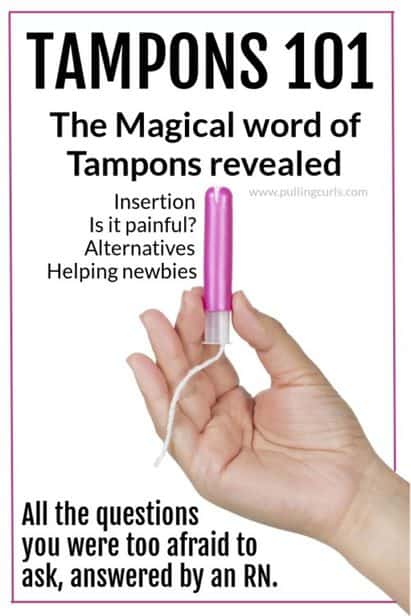
If you’re looking for more posts like this — check out my post on talking to kids about sex.
As always, this content is just for informational purposes and is not intended as medical advice.
Can You Pee With a Tampon In?
Short answer: Yes.
Long answer, let’s talk about what tampons are and why it’s ok/possible to pee with them in.
Definition of a Tampon
A tampon is an absorbent material compressed. You insert it into the opening of your vagina where it soaks up any blood that comes out from your period.
How do you put in a tampon?
Tampons are placed in your vagina. But first, let’s talk about your 3 holes — some basic anatomy. And yes, I have had this talk with women in labor — so I’d certainly have it with any new tampon user. 🙂
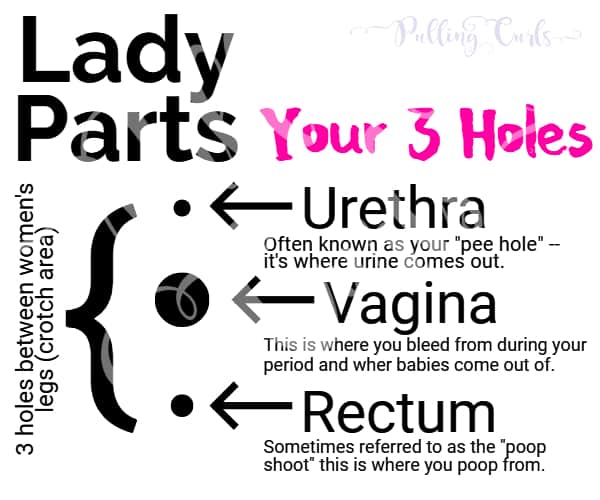
So, going from front to back in medical terms — you have a:
- Urethra — where you pee out of (this is just back from your pubic bone)
- Vagina — where the baby comes out, or blood when you’re on your period
- Rectum — where poop comes out
A tampon will go in the middle hole. While the drawing above isn’t true to size, the vagina is much larger and more flexible than the urethra or the rectum. If you were to try to place it in either of those holes it would be quite painful as they are too small for such an item.
I think it’s helpful to have seen your anatomy before you put it in. Feel free to use a mirror to see where each of the holes is and where you need to aim.
Can I still pee if I have a tampon in?
Yes, as you note above, pee comes out of a separate hole from where you place the tampon.
You MAY get wet strings (you can pull them to the side as you pee), and many women change their tampon when they pee (as you don’t want to leave it in too long — see below where I talk about how long you can leave it in), which is also safe.
My Tampon Gets Filled with Urine
My GUESS, and only as an OB nurse who deals with that area of the body a lot — you aren’t pushing the tampon up high enough. If you push it all the way in, it shouldn’t be in the way of urine.
Also, your string may be hanging into the flow of urine (it’s fine to bundle that up and push it up into your vagina as well). It could wick-up some moisture, but it shouldn’t be filling the tampon with urine.
You may also want to talk to your lady-parts doctor next time you see him/her.
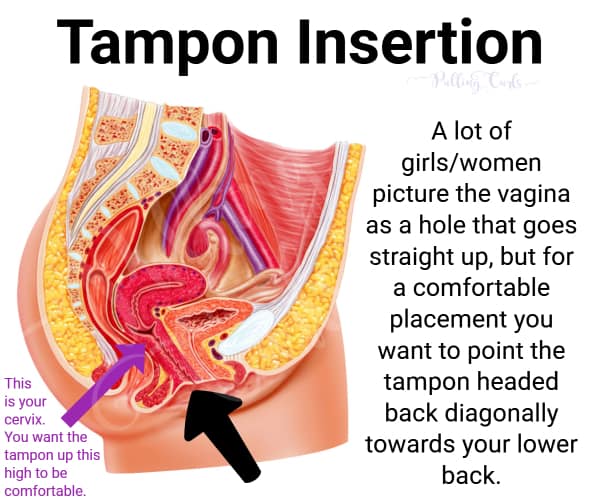
As you can tell from that photo, the vagina is sort of in line with your leg (in that extends backwards rather than straight up). So, you want to point the tampon towards your lower back as you insert.
Two unlikely problems:
If you’ve had a baby or other vaginal surgeries there is a chance that your urethra has somehow sprung a leak into your vagina. I believe that this is called a urogenital Sinus (where the vaginal wall has some trauma and opens up to the urethra. Again, VERY rare. Very unlikely to be the cause.
Some people say that they have difficulties holding their urine when a tampon is in. This could be due to weak pelvic floor muscles that allow the bladder or uterus to fall into the vaginal canal. This would be due to how a tampon would support those organs and keep those organs “up” and out of the way when it’s in — which may change how you prevent the flow or urine. You would want to talk with your provider if you’re having this type of incontinence (and likely get a pelvic floor physical therapist consult).
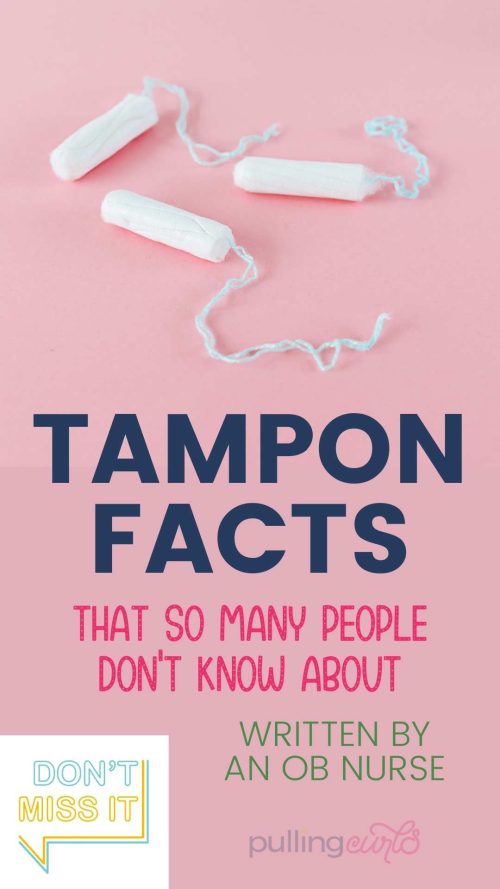
Tampon Insertion
Some tampons come with an applicator (some do not, but most girls find the tampon applicator helpful the first few times, in order to get it in far enough to be comfortable).
- Place the tip of the tampon in your vagina using your thumb and pointer fingers holding the end of the tampon (before the plunger part).
- Once the tampon portion is in up to your fingers — use your pointer finger to push the plunger part of the applicator. That will push the tampon part up in your vagina.
- It will hurt more as you have it in if you don’t push it up all the way, so don’t be timid as you push it up (but also, be gentle and slow if it’s your first time)
- It will have little strings hanging out from the bottom that you will pull to remove (you just pull down on those strings to get the tampon out)
- Throw the applicator in the trash (it cannot be flushed) — that includes both the plunger part (that moves in and out) AND the covering of the tampon itself. Only the compressed cotton/absorbent stuff should stay inside.
This process may be uncomfortable and a bit “scratchy” — but should not be extremely painful (unless you have very little pain tolerance)
It will fill up a large portion of your vagina up to the cervix, which is the bottom of your uterus.
It will catch blood and hang out there until you take it out.

Tips for beginner tampon users
- Use an applicator — use one that talks about “smooth glide” as those really are easier to put in. They may be more expensive but are worthwhile when you’re learning to use it. Later you can try the cheaper kind or even ones without an applicator (which take up less room in your bag). FYI without an applicator, you just use your middle finger to push it up there.
- Some people find it helpful to use one hand to spread your labia minora/majora to widen the vaginal opening.
- Tampons can be placed with one foot on the toilet, or sitting on the toilet, whichever seems easier to you is fine
- Buy the smallest tampon in the beginning. You may need to replace it more frequently, but it will be easier to put in. See the ones I recommend below.
- As you’re learning how to get it in correctly, still wear a pad, pantyliner or period underwear as you may have some leaking from improper placement
- Well-used tampons are much easier to take out than a dry one. I would recommend trying a tampon on a day that you have a larger blood flow as the blood will sort of lubricate the area and make it less painful.
Best Tampons to Buy:
- First-time users I would recommend a plastic applicator
- Want something easy to tuck in your purse — a lot of people love the OB brand.
**If you’re looking for help broaching other sensitive topics — check out my post on talking to kids about sex.
My ❤️ hotels for your Disneyland trip:
– Best Western Park Place — it’s the CLOSEST hotel, has a breakfast and if it’s available for your dates, BOOK IT. If not, check out the Tropicana.
– Cambria – this is my favorite one with a great price point for larger groups – has a water park and free breakfast (not walkable though) – but if you want a walkable suite check out Castle Inn
Can you poop with a tampon in?
You can. It’s a little bit different as the rectum is right along your vagina. If you have a big bowel movement it is possible it may dislodge your tampon and you need to put a new one in. Bearing down when you’re constipated can also move tampons. However, a tampon will not stop you from pooping.
How long can I leave a tampon in for?
The maximum time you should have a tampon in is eight hours.
I usually recommend trying to remove it at 6. For high school girls, think a tampon before school, change it at lunch and again after school. That way you are safe.
Every time you place a tampon, you need to remove it within 8 hours. Most people tend to have the tampon fill with period blood before the 8 hours when they’re up and moving around.
Leaving a tampon in too long can cause toxic shock syndrome where staph can create toxins that can make you very sick.
Tips to prevent TSS from ToxicShock.com
- Always use a tampon with the lowest absorbency suitable for your period flow — the higher absorbency ones have a higher risk
- Use a sanitary towel or panty liner from time to time during your period — often, a night it’s better to just wear a pad or period underwear
- Wash your hands before and after inserting a tampon — that way you’re not shoving other bacteria and you’re keeping the process as clean as possible.
- Change tampon regularly, (you can read more about it on the pack) — usually by 8 hours (but I recommend 6)
- If you use a tampon at night, put it in right before you go to sleep, and remove it when you wake up
- Make sure you remove the tampon at the end of your period.
In all reality, TSS isn’t all that common, not really a big problem — but something to be aware of. TSS cases are actually pretty small for all the information they give you in a box of tampons!
If you happen to have a bacterial vaginosis or other infection of your vagina — do not use a tampon until you are healed.

Is it OK to sleep with a tampon in?
Yes, most people sleep 8 hours, so it fits in that window.
BUT, night time is a good time to give your vagina a rest and use a maxi pad or period underwear.
What do I do if I left a tampon in too long?
Just watch for flu-like symptoms.
Like I said, TSS isn’t all that common, but it is certainly something to watch for. If you get a fever you need to call your healthcare provider ASAP.
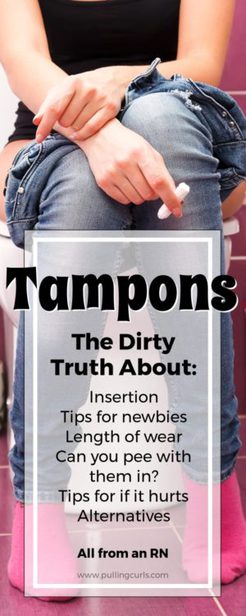
Tampon Faq’s
Are tampons flushable?
The actual TAMPON part is usually flush-able depending on the septic system you’re using. Check the packaging for more info on each brand.
The applicator (if using one) should be placed in the garbage (you can put it back in the wrapper to cover it)
Do Tampons hurt?
A) Tampons can be uncomfortable to put in, but it shouldn’t be extremely painful.
B) If you have placed your tampon and it is still quite painful you likely haven’t gotten it high enough. You can either use your finger to push it higher or remove it and try again.
I can feel my tampon
You might feel it in there but if it’s uncomfortable, it is likely that it isn’t high enough — you can use your finger to push it higher or take it out and try a new one. Sometimes you’ll feel it when you stand, and that may mean it’s full and you need to replace it with a new product.
Yeast infection with a tampon?
I wouldn’t recommend using a tampon if you have a yeast infection.
Bladder Infections with a Tampon?
Tampons should not cause bladder infections, but they can make your urethra extra sensitive. The risk of infection would be in your vagina, not where your pee comes from.
❤️ FAVORITE Disneyland HOTELS of Pulling Curls Readers ❤️
– The Clarion — The price can’t be beat!
– Anaheim Majestic – People love the free shuttle!
– Best Western Anaheim Inn — SO close and great!
– Castle Inn — A FAVORITE with little kids!
– Cambria Hotel – GREAT one for larger parties, and I love their price
Tampon saturated with urine
Tampons aren’t placed in your urethra, so they aren’t getting the flow of urine on them when you pee unless they are sticking out of your vagina.
If that is the case, try to get it higher when you push it up.
Also, some women think it’s a good idea to keep the tampon string tucked up just inside the vagina so you don’t get a wet string when you pee or wipe with toilet paper. That is OK, just make sure you don’t tuck it high enough that you can’t get it out.
Can a tampon easily fall out?
If you use a tampon that is far too small for your vagina, it could possibly. That is likely only going to happen if you have had children though.
Women who have had many children may not be able to use tampons anymore (due to an enlarged vagina, or possible uterine or bladder prolapse) and may prefer an alternative listed below. FYI any pelvic organ prolapse is when they drop down and fall into your vagina due to weak pelvic floor muscles.
When were Tampons invented?
While women have used things through the ages similarly.
The tampon was patented in 1931 — you can read the history of tampons here. #fascinating
Alternatives to tampons
- Period pads — I bet you’ve heard of these before.
- Period Panties — these super absorbent panties can keep your bed clean by absorbing tons of period blod. You just rinse them out and toss them in the wash. These get great reviews.
- Menstrual Cups — while these have been around for a while, they seem to have just come into vogue lately. Make sure you get one that is sized appropriately. This one seems to be the most popular, but this one guarantees being leak free. This kind is different, and might be more comfortable for first time users. My friend Katie has a great article on menstrual cups.
Can you pee with a menstrual cup in?
YES. THREE DIFFERENT HOLES. Remember! Your menstrual cup will go in your vagina. Not your urethra.
Are Tampons Dangerous?
They can be if you don’t use them correctly and make sure you remove them.
But otherwise, no.
Which tampons expand widthways?
That would be the OB kind, most other tampons keep their shape (but absorb fluid, so they do grow a bit).
If you have a heavy menstrual flow the OB kind might hold more (or you may just have to change more frequently).
Which tampons are good for swimming?
All of them are a great option for swimming, and is often the reason why girls want to try them out in the first place.
Just make sure you get them high enough so they aren’t taking on fluid hanging out of your vagina
Where tampons go
Tampons go in your vagina — that’s the middle hole (see picture above).
Where do tampons get stuck
Your tampon goes in your vaginal canal. The walls of the vagina keep your tampon in through friction.
Tampons should not get stuck, and make sure you remove each tampon and especially at the end of your period!
What are tampons made out of?
This is an important question, and only recently have they started disclosing more on the topic. Check the brand you’re using to see if they tell you (they’re all different).
Will tampons leak
Tampons can leak, they come in many different absorbencies, so pick the one that works for you. I recommend buying a few brands to see what works best for you.
You should not use two tampons at once. I would recommend wearing a tampon, and possibly some period panties for extra protection if you have a problem leaking.
Also, change your tampon frequently if you leak.
Will tampons break your hymen
I honestly know very little about the hymen — but this article was helpful. yes, a tampon may break your hymen, but you will still be a virgin.
Breaking your hymen doesn’t mean you’re not a virgin. Not having sexual intercourse makes you a virgin (btw, you might like my article about talking to your kids about sex).
Will tampons leak in the pool
Like all other times, tampons can leak.
I would recommend putting a fresh tampon as soon as you get to the pool, and switching it out when you’re done.
Will tampons make cramps worse
I think they do, but honestly that makes no sense. Cramps are your uterus contracting to get the blood out.
Possibly, by your tampon next to your cervix (the exit of your uterus) it may make it move in a way that is more painful? I have no idea, but I feel like mine are worse when I have a tampon in.
Will tampons stop bladder leakage
You have 3 holes (as we talked about above). Tampons go in your vagina — your urethra is where pee comes out.
Some women wear something to help keep your uterus up and that can help with bladder leakage, so I suppose it’s possible, but I wouldn’t use a tampon — and I’d certainly talk to your doctor. Some women may find stress incontinence worse when a tampon is it (because it is irritating their urethra).
Tampons themselves do not cause urinary incontinence though.
Can tampons cause a Urinary Tract Infection?
If you left a tampon in a long time, I suppose it’s possible… BUT again — your tampon doesn’t go into the hole you pee from (your urethra) it goes in your vagina. Learn more about bladder infections in this post.
Why tampons hurt to take out?
I think they often hurt when you’re just at the beginning of your time of the month — when you just have a light flow, or the end of your period when your flow isn’t as heavy. If it’s quite painful, I would recommend only using a tampon mid-period when it’s absorbing more and it will be easier to take out.
Are tampons meant to feel uncomfortable?
Nope, they shouldn’t be.
Reasons tampons might be uncomfortable:
- You have one that is too large, try a smaller size/absorbancy — or a different brand
- You haven’t pushed it up enough
- You’ve had the tampon in too long and it’s absorbed it’s limit
The good news is that if your tampon is uncomfortable, there are other options.
Are tampons better than pads?
Depends on what you like. Most girls like tampons because they fear leakage less when wearing a tampon.
Are tampons sterile?
Nope, they should be clean but not sterile. Your vagina isn’t sterile either.
Tampons while pregnant
You should not wear a tampon while you are pregnant. If you are spotting, you should just wear a pad.
Tampons when you’re a virgin
Totally fine. Again, wearing a tampon doesn’t stop you from being a virgin. Having sex does that.
Tampons will likely be easier to put in when you have sex frequently as your vagina will stretch out a bit.
And, as you have children, your vagina will stretch more — and you may need a different size/brand.
Tampons when trying to conceive
It shouldn’t be problematic, as you’d only wear your tampon when you were on your period, and that isn’t a time to conceive anyway.
Some people are very concerned about the ingredients in tampons, so — that might be something worth exploring
If you liked this post, sign up for my family health tips:
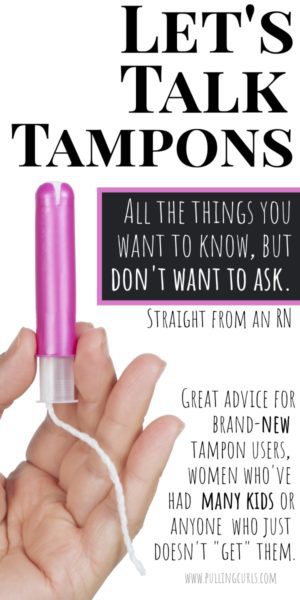
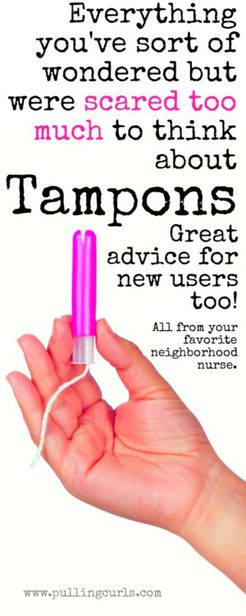


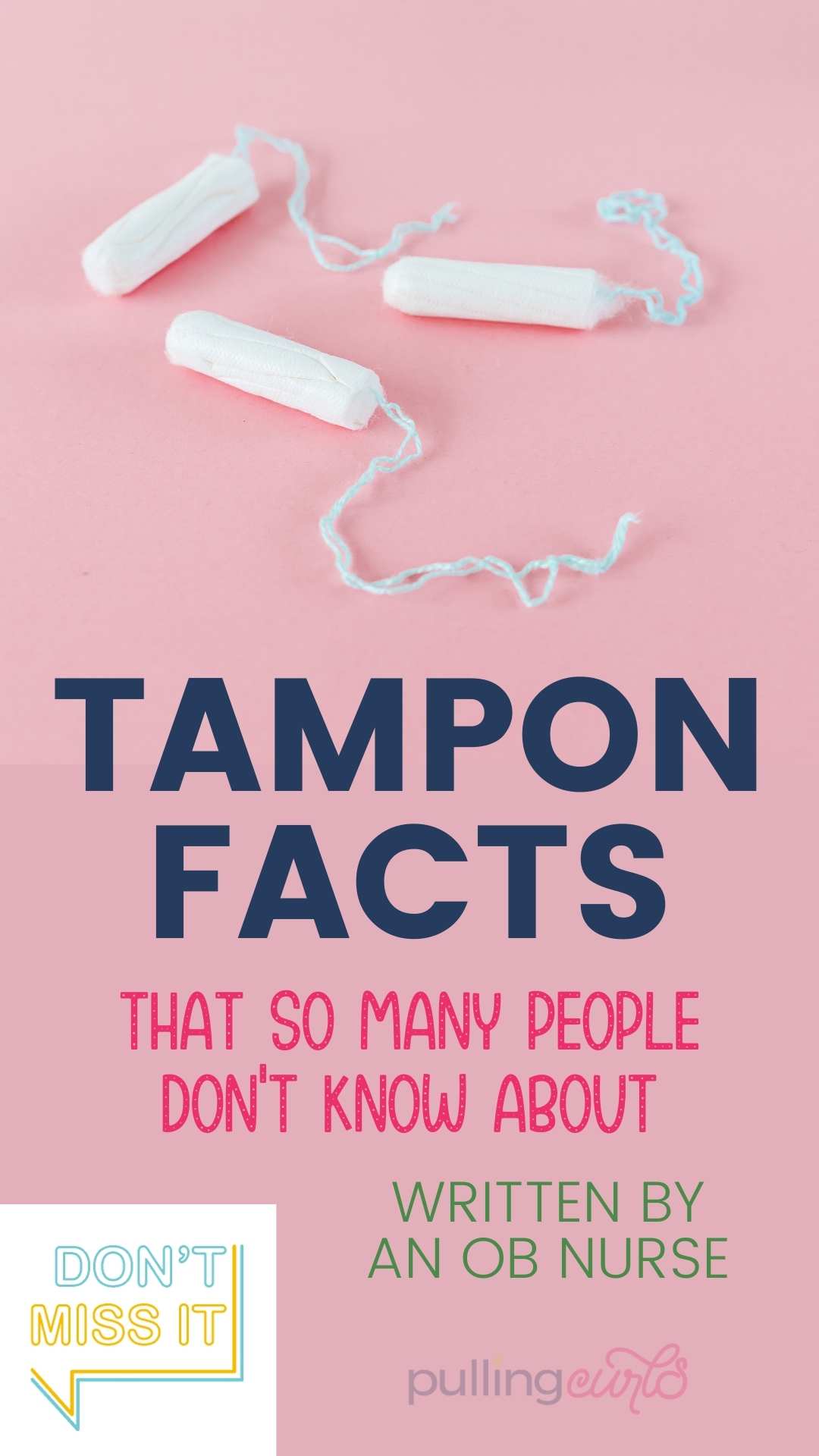






selina says
You have explained it such beautifully that I am truly inspired it is very informative for girls.
Hilary Erickson says
Oh, I am so glad. 🙂
Kirtika saha says
Thank you for the introduction of a range of information that is very interesting to see in this article.